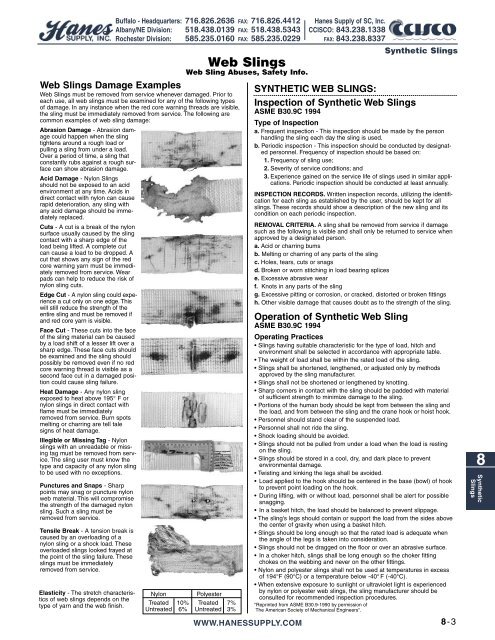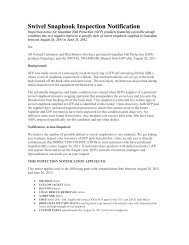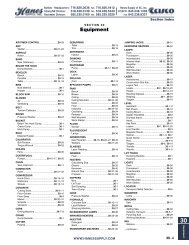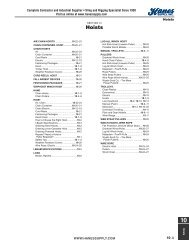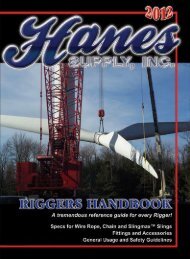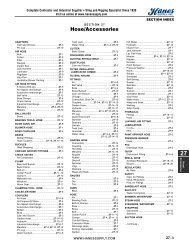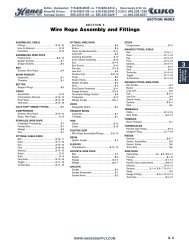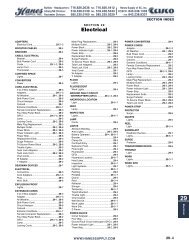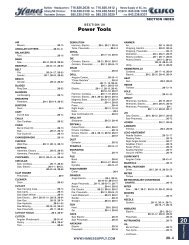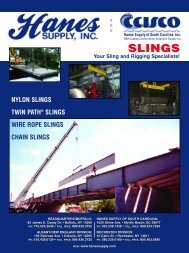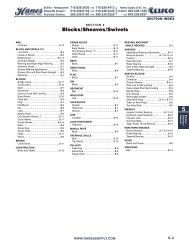Synthetic Slings - Hanes Supply, Inc
Synthetic Slings - Hanes Supply, Inc
Synthetic Slings - Hanes Supply, Inc
Create successful ePaper yourself
Turn your PDF publications into a flip-book with our unique Google optimized e-Paper software.
Buffalo - Headquarters: 716.826.2636 FAX: 716.826.4412<br />
Albany/NE Division: 518.438.0139 FAX: 518.438.5343<br />
Rochester Division: 585.235.0160 FAX: 585.235.0229<br />
Web <strong>Slings</strong> Damage Examples<br />
Web <strong>Slings</strong> must be removed from service whenever damaged. Prior to<br />
each use, all web slings must be examined for any of the following types<br />
of damage. In any instance when the red core warning threads are visible,<br />
the sling must be immediately removed from service. The following are<br />
common examples of web sling damage:<br />
Abrasion Damage - Abrasion damage<br />
could happen when the sling<br />
tightens around a rough load or<br />
pulling a sling from under a load.<br />
Over a period of time, a sling that<br />
constantly rubs against a rough surface<br />
can show abrasion damage.<br />
Acid Damage - Nylon <strong>Slings</strong><br />
should not be exposed to an acid<br />
environment at any time. Acids in<br />
direct contact with nylon can cause<br />
rapid deterioration, any sling with<br />
any acid damage should be immediately<br />
replaced.<br />
Cuts - A cut is a break of the nylon<br />
surface usually caused by the sling<br />
contact with a sharp edge of the<br />
load being lifted. A complete cut<br />
can cause a load to be dropped. A<br />
cut that shows any sign of the red<br />
core warning yarn must be immediately<br />
removed from service. Wear<br />
pads can help to reduce the risk of<br />
nylon sling cuts.<br />
Edge Cut - A nylon sling could experience<br />
a cut only on one edge. This<br />
will still reduce the strength of the<br />
entire sling and must be removed if<br />
and red core yarn is visible.<br />
Face Cut - These cuts into the face<br />
of the sling material can be caused<br />
by a load shift of a lesser lift over a<br />
sharp edge. These face cuts should<br />
be examined and the sling should<br />
possibly be removed even if no red<br />
core warning thread is visible as a<br />
second face cut in a damaged position<br />
could cause sling failure.<br />
Heat Damage - Any nylon sling<br />
exposed to heat above 195° F or<br />
nylon slings in direct contact with<br />
flame must be immediately<br />
removed from service. Burn spots<br />
melting or charring are tell tale<br />
signs of heat damage.<br />
Illegible or Missing Tag - Nylon<br />
slings with an unreadable or missing<br />
tag must be removed from service.<br />
The sling user must know the<br />
type and capacity of any nylon sling<br />
to be used with no exceptions.<br />
Punctures and Snaps - Sharp<br />
points may snag or puncture nylon<br />
web material. This will compromise<br />
the strength of the damaged nylon<br />
sling. Such a sling must be<br />
removed from service.<br />
Tensile Break - A tension break is<br />
caused by an overloading of a<br />
nylon sling or a shock load. These<br />
overloaded slings looked frayed at<br />
the point of the sling failure. These<br />
slings must be immediately<br />
removed from service.<br />
Elasticity - The stretch characteristics<br />
of web slings depends on the<br />
type of yarn and the web finish.<br />
Web <strong>Slings</strong><br />
Web Sling Abuses, Safety Info.<br />
Nylon<br />
Polyester<br />
Treated 10% Treated 7%<br />
Untreated 6% Untreated 3%<br />
WWW.HANESSUPPLY.COM<br />
<strong>Hanes</strong> <strong>Supply</strong> of SC, <strong>Inc</strong>.<br />
CCISCO: 843.238.1338<br />
FAX: 843.238.8337<br />
SYNTHETIC WEB SLINGS:<br />
Inspection of <strong>Synthetic</strong> Web <strong>Slings</strong><br />
ASME B30.9C 1994<br />
Type of Inspection<br />
a. Frequent inspection - This inspection should be made by the person<br />
handling the sling each day the sling is used.<br />
b. Periodic inspection - This inspection should be conducted by designated<br />
personnel. Frequency of inspection should be based on:<br />
1. Frequency of sling use;<br />
2. Severity of service conditions; and<br />
3. Experience gained on the service life of slings used in similar applications.<br />
Periodic inspection should be conducted at least annually.<br />
INSPECTION RECORDS. Written inspection records, utilizing the identification<br />
for each sling as established by the user, should be kept for all<br />
slings. These records should show a description of the new sling and its<br />
condition on each periodic inspection.<br />
REMOVAL CRITERIA. A sling shall be removed from service if damage<br />
such as the following is visible and shall only be returned to service when<br />
approved by a designated person.<br />
a. Acid or charring bums<br />
b. Melting or charring of any parts of the sling<br />
c. Holes, tears, cuts or snags<br />
d. Broken or worn stitching in load bearing splices<br />
e. Excessive abrasive wear<br />
f. Knots in any parts of the sling<br />
g. Excessive pitting or corrosion, or cracked, distorted or broken fittings<br />
h. Other visible damage that causes doubt as to the strength of the sling.<br />
Operation of <strong>Synthetic</strong> Web Sling<br />
ASME B30.9C 1994<br />
<strong>Synthetic</strong> <strong>Slings</strong><br />
Operating Practices<br />
• <strong>Slings</strong> having suitable characteristic for the type of load, hitch and<br />
environment shall be selected in accordance with appropriate table.<br />
• The weight of load shall be within the rated load of the sling.<br />
• <strong>Slings</strong> shall be shortened, lengthened, or adjusted only by methods<br />
approved by the sling manufacturer.<br />
• <strong>Slings</strong> shall not be shortened or lengthened by knotting.<br />
• Sharp corners in contact with the sling should be padded with material<br />
of sufficient strength to minimize damage to the sling.<br />
• Portions of the human body should be kept from between the sling and<br />
the load, and from between the sling and the crane hook or hoist hook.<br />
• Personnel should stand clear of the suspended load.<br />
• Personnel shall not ride the sling.<br />
• Shock loading should be avoided.<br />
• <strong>Slings</strong> should not be pulled from under a load when the load is resting<br />
on the sling.<br />
• <strong>Slings</strong> should be stored in a cool, dry, and dark place to prevent<br />
environmental damage.<br />
• Twisting and kinking the legs shall be avoided.<br />
• Load applied to the hook should be centered in the base (bowl) of hook<br />
to prevent point loading on the hook.<br />
• During lifting, with or without load, personnel shall be alert for possible<br />
snagging.<br />
• In a basket hitch, the load should be balanced to prevent slippage.<br />
• The sling's legs should contain or support the load from the sides above<br />
the center of gravity when using a basket hitch.<br />
• <strong>Slings</strong> should be long enough so that the rated load is adequate when<br />
the angle of the legs is taken into consideration.<br />
• <strong>Slings</strong> should not be dragged on the floor or over an abrasive surface.<br />
• In a choker hitch, slings shall be long enough so the choker fitting<br />
chokes on the webbing and never on the other fittings.<br />
• Nylon and polyester slings shall not be used at temperatures in excess<br />
of 194°F (90°C) or a temperature below -40° F (-40°C).<br />
• When extensive exposure to sunlight or ultraviolet light is experienced<br />
by nylon or polyester web slings, the sling manufacturer should be<br />
consulted for recommended inspection procedures.<br />
"Reprinted from ASME B30.9-1990 by permission of<br />
The American Society of Mechanical Engineers".<br />
8-3<br />
8<br />
<strong>Synthetic</strong><br />
<strong>Slings</strong>


